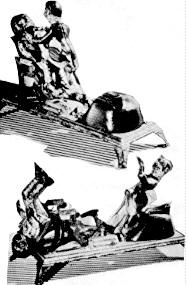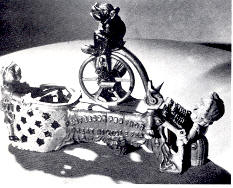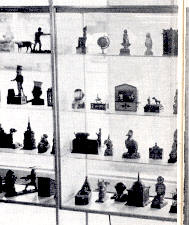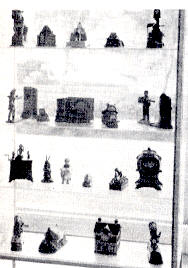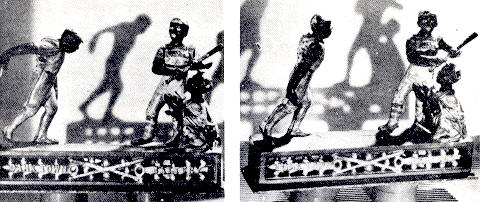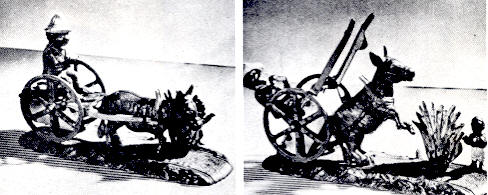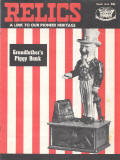 RELICS,
A LINK TO OUR PIONEER HERITAGE RELICS,
A LINK TO OUR PIONEER HERITAGEApril, 1970, Vol. 3, No. 6 Whole number 14, pages 4, 5, and 26. A magazine devoted to the treasures, artifacts, relics and collectibles intimately associated with the expansion and development of the vast frontier. Courtesy Morton L. Levy Gibraltar Savings Association
Today Gibraltar's collection of the intricate cast-iron banks is among
the few of its kind in the United States. The collection, now numbering
about 125 models, is displayed in two cases in Gibraltar's lobby. The late vice president Walter Godlove was curator of the collection, which is owned by the firm itself. Not only was Mr. Godlove an enthusiastic collector and authority on antique banks but he was also a firm believer in their value as advertising and publicity media. "If you think Mr. Average Man and his wife aren't just
grown-up children," he said, "just place a few of these entertaining
mechanical coin banks in action where the public can see them. See the
beaming smiles on the faces of the watchers. Listen to the amused chuckles
and note the eager willingness with which anyone in the audience will try
out a
A coin was placed in the
pitcher’s hand and when the lever was pressed, the pitcher’s arm jerked
The use of coin banks had become popular in the United States at the end of the eighteenth century when the first large copper pennies were coined. It was not until approximately 1870, however, that cast iron was used in the manufacture of coin banks. They reached their greatest popularity during the last quarter of the nineteenth century. Many ingenious and elaborate figures that moved and performed amusing feats while depositing the coins, were invented and put on the market.
Another spring-action bank.
When the boy stepped in front of the donkey, The banks sold for only $2.00 or $3.00 — incredibly cheap in view of
the skill and ingenuity that went into their manufacture. In spite of the
mass production and technological efficiency of our age, the cost of
making the banks today would be prohibitive. In fact, Gibraltar considered
turning out a modern mechanical bank as an advertising stunt but dropped
the idea when confronted with how much the casting of the original dies
would cost. The rarest item in the Gibraltar collection is the so-called elephant bank. Several years ago a collector and dealer in antique banks happened across the sales catalogue of an old foundry located in a small town in northern Michigan. Among the items listed as manufactured by the foundry was the elephant bank, and a picture of it was shown. The dealer had never seen or heard of the elephant model before and he began a quiet investigation. He learned that the old foundry had burned many years before. On a hunch, he journeyed to the little town where it had been located and found the site on which it had stood. Like any good relicker, he started poking among the weed-grown debris left from the fire. Buried in the rubble he found a box containing the cast iron parts of some elephant banks. Using the catalogue illustration as a guide, he assembled twenty of the banks and offered them to collectors throughout the country. They were snapped up, of course. Gibraltar paid over $100 for its bank and has been offered more than twice that much for it. Of course, it is not for sale. |


